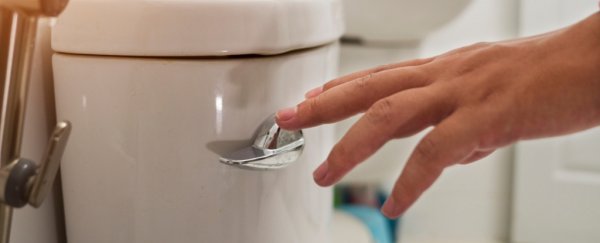We know our poop carries all sorts of pathogens. There have been some indications even the COVID-19 virus could be found in faeces, lending just one more reason to thoroughly wash our hands. But what about using the toilet itself?
A new study modelling the fluid dynamics of toilet flushing has found it can send droplets from the bowl nearly one metre (three feet) in the air, where the tiniest particles - like viruses - could stay aloft for over a minute.
"One can foresee that the velocity will be even higher when a toilet is used frequently, such as in the case of a family toilet during a busy time or a public toilet serving a densely populated area," says Ji-Xiang Wang from Yangzhou University in China.
Using computational fluid dynamics, the authors of the study simulated how droplets in a toilet are whipped up into a frenzy when flushed, and can indeed splurt out of the bowl too, carrying potential pathogens with them.
In their simulations, the team compared two common types of flushing toilet: one with a single inlet that fills up the toilet bowl from just one source of water, and one with two symmetrical inlets, to simulate the annular flushing toilet where the water enters the bowl from the entire underside of the rim.
"The volume-of-fluid (VOF) model is used to simulate two common flushing processes (single-inlet flushing and annular flushing), and the VOF–discrete phase model (DPM) method is used to model the trajectories of aerosol particles during flushing," the team writes in their paper.
"The simulation results are alarming in that massive upward transport of virus particles is observed, with 40 percent to 60 percent of particles reaching above the toilet seat."
While it's a cool way to crunch the numbers, it's important to remember the team worked with simulated fluids and aerosols, and didn't really test whether a viral particle that flies up in the air and lands on the toilet seat is guaranteed to make you sick.
Still, the idea is understandably icky. A simple solution to avoid this vortex of poop droplets is to close the lid before you flush, but unfortunately, many public restrooms don't provide this feature.
"The daily flow of people in a public washroom is stunningly large: thus, a confirmed case may cause a massive number of infections. For these reasons, investigation of toilets in the context of epidemic prevention is imperative," the authors write.
The researchers offer some pretty common sense precautions when using public toilets: clean the seat before using it, flush with the lid closed if there is one, and wash your hands carefully afterwards.
The study was published in the Physics of Fluids.
